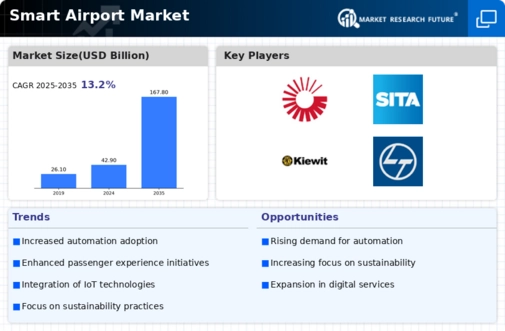Market Share
Smart Airport Market Share Analysis
The Smart Airport market is experiencing transformative trends that reflect the industry's commitment to enhancing efficiency, passenger experiences, and overall operational excellence. One prominent trend is the increasing integration of biometrics and contactless technologies to streamline passenger journeys. From check-ins to security checks and boarding processes, airports are adopting biometric authentication methods such as facial recognition to provide a seamless and touchless travel experience. This trend aligns with the growing emphasis on health and safety in the post-pandemic era, offering passengers a more hygienic and efficient passage through airports.
The rise of Artificial Intelligence (AI) and data analytics is another noteworthy trend in the Smart Airport market. Airports are leveraging AI algorithms to analyze vast amounts of data in real-time, providing insights into passenger behavior, operational inefficiencies, and security threats. Predictive analytics enable airports to optimize resource allocation, anticipate passenger flows, and enhance overall operational decision-making. This data-driven approach contributes to more agile and responsive airport management, improving both efficiency and the passenger experience.
Automation and robotics are shaping the landscape of smart airports, driven by the quest for operational efficiency. Automated check-in kiosks, robotic baggage handling systems, and autonomous ground vehicles are becoming commonplace in smart airport infrastructure. These technologies reduce labor costs, minimize processing times, and enhance the accuracy of various airport operations. Robotics are increasingly employed in tasks such as cleaning, maintenance, and even customer service, leading to a more streamlined and cost-effective airport environment.
The deployment of Internet of Things (IoT) devices and sensors is a pervasive trend in smart airports, contributing to the creation of connected and intelligent airport ecosystems. IoT technologies enable airports to gather real-time data on various aspects of operations, including facility management, equipment status, and passenger movements. This interconnected network of devices facilitates proactive maintenance, resource optimization, and improved situational awareness, laying the foundation for smarter and more responsive airports.
The emergence of smart security solutions is a critical trend in response to evolving threats and security challenges. Smart airports are investing in advanced security technologies such as AI-powered video surveillance, biometric identification, and threat detection systems. These technologies enhance the effectiveness of security measures while minimizing disruptions for passengers. The integration of smart security solutions ensures a robust and adaptable security infrastructure capable of responding to dynamic and complex security scenarios.
Sustainability and environmental consciousness are becoming central themes in the smart airport market. Airports are increasingly adopting eco-friendly technologies, including smart energy management systems, solar power generation, and waste recycling initiatives. This trend aligns with the broader global push for sustainable practices and reflects the aviation industry's commitment to reducing its environmental footprint. Green airport initiatives not only contribute to environmental conservation but also appeal to passengers and stakeholders increasingly prioritizing sustainability.
The convergence of airport operations and digitalization is evident in the growing trend of end-to-end digital airport solutions. From self-service check-ins to baggage tracking and wayfinding apps, airports are embracing comprehensive digital platforms to offer passengers a holistic and connected travel experience. These solutions contribute to operational efficiency, improve passenger satisfaction, and position smart airports as technologically advanced hubs.
The impact of the COVID-19 pandemic continues to influence market trends in the smart airport industry. The focus on health and safety measures has accelerated the adoption of touchless technologies, contactless payment systems, and health screening solutions. Smart airports are implementing measures such as temperature screening, social distancing monitoring, and touchless check-ins to ensure passenger well-being and compliance with health protocols. This trend underscores the industry's adaptability and commitment to addressing evolving challenges.
Collaborations and partnerships between airports and technology providers are fostering innovative solutions and driving market trends. As the smart airport ecosystem becomes more complex, collaborative efforts are essential to creating integrated and interoperable solutions. These partnerships contribute to the seamless exchange of data and information, enhancing the overall connectivity and functionality of smart airport systems.








Leave a Comment